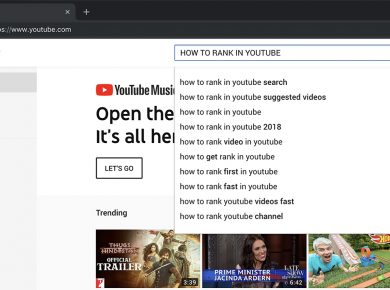Being a coach is one of the most rewarding careers you could ever have.
You help people…
You motivate people…
People look up to you…
You are a role model in your niche…
You offer people the daily escape they need from their everyday lives…
You change lives forever…
Among so many other amazing things.
There is a lot to be grateful for in this career that could be the subject of a future article all in itself, but what I want to talk about today doesn’t revolve around a career… because for most coaches this is just a job.
When coaches say they “aren’t in it for the money” – I know that sounds cool to say and that you sound like you have integrity and all that other stuff, but, it doesn’t sound so cool when your roof has a hole in it and you can’t afford to fix it.
Or if someone in your family gets sick and there’s no way you can afford it…
Or when the car breaks down you need to ask for rides from all your friends and family because you need to wait for the next paycheck to sort things out…
Or if your spouse has had a dream vacation their entire life but has never been able to see it through because it would set you too far back in your bills…
These things are all unfortunately driven largely by finances. So, whether you are doing for the money or not is irrelevant in my opinion because you’re going to need to find a way to make money regardless.
That’s what I want to talk with you today about, how to stop limiting yourself in the world of finances by stopping the continuing path of your hourly rate.
Looking at Both Sides of The Equation
Getting paid by the hour sounds very logical in this industry, which is why no one really questions it at all when they first start.
You show up to the gym, work with your client, get paid for the time that you’re there, and go home.
Makes sense, right?
Well, kind of. But it’s also an old-school way of thinking, for both the coaches and the gym owners.
In my opinion, getting paid by the hour is the least effective thing you can do to generate more revenue for yourself and your team.
Too many coaches and gym owners don’t look at the negative side to this equation because they just accept the hourly rate as “the way it is”, but, consider this:
- You will always be bound to a perceived monetary ceiling the house can charge (in your mind and the clients)
- The client will immediately compare you to the other equivalent rates in the industry (and even outside of the industry) who provide a similar service
- You and/or your team can only work so many hours per week, so you will top out your income the moment you become even a moderately popular trainer
- When you sell yourself by the hour the conversation is always focused on the hourly rate rather than what you can do to help the client
- Fitness isn’t built one hour at a time, so why do we sell it that way?
Breaking Down the Logistics
Let’s say you’re going to increase your hourly rate to $100 per hour.
In the personal training market, this is usually a lot of money, especially since both we and the client already believe that we should be charging per unit of hour worked.
Just think about it for a second.
The trainer is going to think:
“I’m going finally make that jump to $100 per hour, this is the most I have ever charged anyone!”
But, since this is a lot of money to the trainer, their ability to ask for this sum is now weakened. It takes a very mature, experienced, and financially knowledgeable person to look their prospect in the eye and ask for more money than they have ever asked for before.
The majority of trainers stumble here, pretty hard too.
The trainer probably got into the field because he/she was internally driven and loved helping others. The problem here is that so many coaches love training and helping people so much that they would be willing to do it for low pay, or sometimes even for free.
This internal drive is what drives coaches to say things like:
“I’m not here for the money”
But realistically speaking, you have to be at some point or else life is going to kick your ass because that doesn’t put food on the table or keep your lights on.
The client on the other hand often has no knowledge of what trainers in our market get paid, so they will just immediately compare you to your competition.
In my opinion, you should be the most expensive trainer at your gym, but there are of course limits as to how far you can push that idea.
Anybody who knows anything about business development understands that the higher you charge for your services, the greater the perceived quality of service and outcome will be.
This thought is normally in direct combat with the thinking that so many trainers have who constantly make deals, create non-existing payment plans, and charge the least in their market in order to make a sale.
This is one of the hardest lessons you will learn in this industry, but also one of the best. The above idea of thinking is completely flawed and totally unsustainable in the long-term, and the only people who will tell you otherwise are the ones still trapped in that rat race.
The Fitness Industries Living Contradiction
The contradiction that so many coaches find themselves in is when what you’re asking for doesn’t match anything around you or anything about you.
For example, if you want to hire a dentist for $25 per hour you’re going to see the office match the rate he’s charging.
Bad clothing, small office, no parking, no assistant, poor location, old equipment, and no experience in dental work are all signs of a $25 per hour dentist.
On the other hand, hiring a dentist for $300 per hour would completely match the rate.
Dressed professionally, multiple assistants, state of the art equipment, great location, lots of parking, and all of the trappings, experience, and poise it would take to confidently charge $300 per hour.
In our industry though, you see coaches trying to charge their “highest rate ever” ($100 per hour) in the same building where all the other cheap trainers live and work.
This trainer wants to charge more and better himself, but he is dressed the same as the jokers in his gym and he is also working under the exact same roof that they are.
What’s worse is this trainer who wants to charge more seldom understands that he needs to add more value in his packages and not just “try to charge a little more because I did a new certification last weekend”
It isn’t what you know, it’s how you deliver what you know that makes the real money in this industry.
In the world of dentists, the difference between the worst and the best is vividly apparent.
But in our world, the gap of difference between a great trainer and a crappy trainer is often much smaller through the eyes of our clients because they are seeing us through the lens as:
“Well, they are both dressed the same, both look in shape, and both work in the same building – so there can’t be much of a difference between these two, if any at all”
Let me tell you something I don’t want you to ever forget:
The price someone will pay for your services is based on the perception of quality service you have to offer, and not just what you know.
That’s the difference between a superstar trainer who makes a career out of this game and the coaches who use it as a part-time job.
Surviving the Steep Competition
Another huge problem we run into as coaches when we charge on a per hour basis is that we get compared to certain professionals who, on paper, appear more valuable and/or educated than we are.
For example, massage therapy and chiropractic work are both considered medical professions and they have serious sanctioning bodies governing how they operate, yet they often only charge $50-80 per hour.
Since you’re charging per hour, your prospect is now going to immediately compare you to a medical professional.
In your prospects mind, they are now thinking:
“Ok, I can have this trainer on my team or a medical professional on my team, who is going to provide more value?”
That’s not an easy battle to win, but the battle can be won with the delivery of your service by including things like:
- A quick start package for them to take home
- Dressing professionally
- Where you choose to train the client
- The quality of equipment you train your client with
- What type of support services you offer your client when they’re not in the gym
- Nutritional coaching
Among many other things, you get the idea. The lesson here is that you need to build more value into your packages to the point where your value exceeds your cost, so no matter how your client views the comparison between you and your competition, you always come out on top because they get so much more by choosing you.
The Income Trap of Working by The Hour
This will definitely be the subject of a future blog (or maybe podcast since I’d like to yell a little about it), but when we view it very simply it doesn’t take long to get that you are extremely limited in both your income and your life quality by working on an hourly rate.
Here’s just a few reasons why this isn’t a good idea for you:
- There will come a day where you don’t want to work six days a week, plus random weird shift work, sometimes early mornings, sometimes late nights, and everything else you can imagine all at the same time.
- You can train 40 clients per week, but for how long? Your ability to maintain a hectic schedule with 40 on the floor sessions per week is limited, trust me.
- The max money you will ever make is your hourly rate multiplied by your on the floor sessions. So, if you only work 40 sessions a week, then your money ceiling will forever be at 40 sessions per week minus all the costs associated servicing that client, your taxes, keeping your house livable, travel, vacation, and business costs.
- At some point you’re going to want to see your kids after school instead of train everybody who is just getting off work.
- The more hours you train clients per week the less enthusiastic and effective of a coach you become. Split shifts, meals in plastic containers, and listening to your client’s issues in their personal lives drains you down whether you’re willing to admit it or not.
Being a coach for a living is extremely difficult. Working in the per hour race with the same level of passion and commitment day in and day out is extremely difficult even for the most inspiring of coaches.
Rest, decent food, and new things to keep you fresh and excited are a must if you want this to be a career and not just a job.
How do you get out of this rut and plan for the future?
Sell solutions, not hours.
One Big Way to Start Making More Money Now
The first way you can start making more money right now is through moving the majority of your training from 1-on-1 sessions to small group sessions of working with 3 or 4 people at a time.
This is great because it’s not a group class, you can still give people the attention they need, they get better results because they motivate each other, and your hourly rate goes up tremendously during this time.
This means you can work less and make the same money or work more and make much more money.
The best part?
You shifted the focus away from you and onto the group, this means you will deal with way less “personal talk” that drains your energy everyday.
To get this started, sell the solution and not the hours.
For example, let’s say you get your typical client who comes in and wants to lose a little weight and get healthier.
It makes no sense at all for you to sell this person a five-session package (which is one of the dumbest things in the world) or sell them on any hourly package at all for all of the reasons we have discussed above.
Let’s say you charge $50 per hour, instead of discussing this, we are going to sell your client a three month “Rebuild Your Health!” package for only $549 bucks.
This package includes:
- 10 sessions per month in a small group setting
- Nutritional coaching guide sent to their inbox
- A workout journal
- A t-shirt with your company brand on it
Now let’s say you only get 4 people into this, which would make up your 4-person small group training session.
4 x $549 = $2196.00
But, since it’s still only 10 hours per month (or, 30 hours over the course of the 3-month package) no matter how many people show up, your time investment is still the exact same.
At your old rate of $50 per hour you would have made $1500.00 for 30 hours of your time, but now since you’re packaging it together and selling a solution instead of a problem and also doubling/tripling up on your return on investment per hour from each session – you’re going to make $2196.00 for the same amount of time.
That, my friends, is how you make almost 50% more revenue per hour than you were previously.
Now think about when you have several of these going at the same time?
Your road to a much more lucrative income just got a lot brighter, and we haven’t even discussed you leveraging your skills online at all in this article.
Final Thoughts
The above example is just one model of many different models you could use the schedule, price, and structure your program.
Ultimately what you charge and add-on to the package is up to you, but the biggest takeaway I want you to have is to always sell solutions moving forward from here and get away from the idea of selling sessions.
Your goal should be to net around 40-50% on everything you do – but your long-term game is to get paid for what you know and not just how much time you spend on the floor. You’re already working your butt off, it’s time to start getting paid for it.








